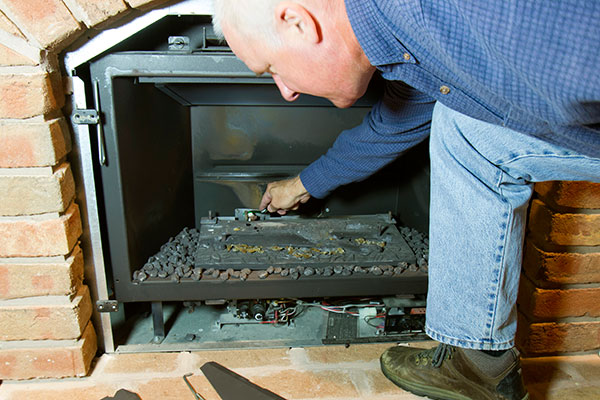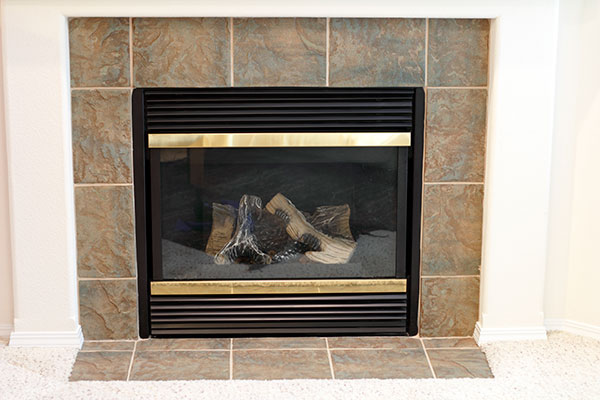
When the days get longer and the weather begins to warm, your fireplace will likely see less and less use. The hottest months of spring and summer are on their way, and it’s important that you don’t simply ignore your fireplace without properly closing it. If you’re not sure how to close a fireplace for spring or summer, read on to learn tips that will help you do it safely and without damaging your fireplace or its accessories.
Cleaning Your Fireplace
The first step to closing your fireplace for the season is to handle some of the basic cleaning.
Remove Unused Firewood
If you have firewood sitting in your fireplace that hasn’t been used, don’t just leave it there. Your firebox is a safe place to burn wood – but not necessarily the ideal place to store it. The biggest risk is that it will attract pests. Termites in your home can be an expensive problem, and having easily-accessible wood will encourage them to move in.
The best thing you can do is simply use the wood. If the weather hasn’t completely warmed up yet, have a brief springtime bonfire and enjoy the last bits of the winter season. Some of your excess wood can be left for another season but remember that while it’s bad to burn green wood, excessively dry wood can be problematic too!
Clean Any Ashes
If you don’t frequently clean your fireplace throughout the season, you will undoubtedly have a pile of ashes left all over the firebox. Ashes aren’t only a nuisance if you breathe them in, they’re also corrosive. It’s damaging to your fireplace to leave them in – which is why you should make a habit of cleaning them after a fire.
The key to cleaning your ashes is to be careful and take it slow. If you try to sweep them up quickly, you’ll send them flying and create a mess. For safety reasons, never try to clean ashes until they’re completely cooled. Even hours after a fire, some remnants of a flame can exist, so be very careful!
If you have a shop vac that’s designed to handle substances like ashes, it can be an easier way to completely clear the base of your firebox.
While this will help you get your fireplace nice and clean, it’s no substitute for a professional chimney sweep. Without the tools and expertise to clean the entire firebox and flue, your chimney could have dangerous creosote deposits or other corrosive materials left in it. Schedule a chimney cleaning from a CSIA-certified expert!
Clean Your Grate/Andirons
In addition to the firebox, any accessories you have in your fireplace should be cleaned. This will help remove any deposits of corrosive byproducts from them and keep them looking spotless for years.
Cast iron is a common type of material for fireplace grates. If you have cast iron, it will have been treated with iron paste that protects it from moisture damage. For this reason, you don’t want to actually clean your grate with typical household cleaners and wet cloths. You can use a show brush or similar dry brush to clean away as much of the debris as possible.
Like your fireplace and flue, it’s easy to make mistakes and damage your accessories or expose yourself to harmful chemicals. Unless you know what you’re doing, this is another step that is best left to the professionals!
Inspect Your Fireplace & Firebox
When you’re finished cleaning, you can take a quick look over every easily-visible area of your fireplace to identify potential concern areas. You may notice sections with high corrosion, damaged brick or other signs of damage.
Check for Leaks
You may check for leaks all over your home and still skip the most important one: your fireplace. While doors and windows are common places for leaks to spring up, your fireplace can also let moisture into your home.
Moisture in a fireplace can be more problematic than in other places of your home. For starters, the tall flue is difficult to access for those without chimney tools or experience. At Doctor Flue, we use specialized cameras to inspect the deepest reaches of your flue system – something most homeowners won’t have access to.
Additionally, leaks in your chimney can allow mold to grow for weeks or months before you notice it. If you keep the glass door closed, or don’t use the room with your fireplace that often, the mold may grow out of control before you identify the symptoms.
Spring and summer will bring plenty of rain around the Great Lakes region from Toledo to Detroit, so now is a good time to find and repair leaks that your chimney may have.
Check for Damage
Another potential concern with your chimney is that, over time, the brick or lining can become damaged. Unlike leaks that may have obvious visual indicators, damage to your chimney can be harder to find.
The easiest places for you to identify damage, are visible when looking directly into the firebox: the backing, the base and the visible walls. If you notice common masonry issues like spalling bricks or deteriorating mortar, it’s important that you get them repaired.
Beyond those problems, you’ll need chimney sweep to do a more thorough inspection up the chimney itself. Damage to your chimney is a serious matter – it can lead to dangerous risks like chimney fires or poor airflow that can lead to carbon monoxide poisoning.
Closing the Damper
The damper in your fireplace helps you control the flow of air when your fireplace is being used or not. When you have an active flame going, you want to leave the damper open so the smoke can escape through the flue. But when you aren’t using your fireplace, leaving the damper open can allow warmth out and cold air in.
Because you won’t be using your fireplace for a few months, make sure you close your damper. If you don’t use your damper often. This is usually easy to do and involves using either the lever or a pull chain, depending on the type of damper you have.
Should You Turn Off Your Pilot Light?

For those with gas fireplaces, one common question is whether they should turn off the pilot light for their gas fireplace during the warmer months when it will see no use. There are a few benefits to turning off your pilot light, assuming you know how to safely disable it and reenable it during the winter again!
#1. Save Money – Depending on your gas source, a pilot light does cost you some money even if you never turn on your fireplace. This cost can range up to nearly 25 dollars per month at its highest, but for most homes will not be that high.
#2. Safety – An active flame, no matter how small, is always at least a minor risk. While gas fireplaces that have been correctly installed are extremely safe, it never hurts to reduce that risk by turning off an unnecessary pilot light.
#3. Reduce Sulfur – Leaving your pilot light on can allow a small sulfur build-up over time on the glass doors of your fireplace. This film can etch into the glass if not regularly cleaned. Turning off the pilot light prevents this from happening.
#4. Unnecessary Heat – A pilot light generates heat, even if only a little. During the hottest days of the year, the last thing you want is your favorite room feeling even one degree warmer.
Hire a Professional Chimney Sweep
CSIA-certified experts know how to close a fireplace for spring or summer in the safest way – checking for every potential sign of damage, leaks or potential concerns. Even if you don’t often use your fireplace, it’s important to allow a professional to inspect and clean it at least once per year to keep your home safe.
The cost of a chimney inspection is far less than the potential damage from mold and moisture or invading critters!
Contact Doctor Flue for Help Closing Your Fireplace!
The CSIA-certified experts here at Doctor Flue offer chimney services and products in Michigan and Ohio and can inspect your chimney and help close it for the season. Contact us today! We’ll get you set up right away so you can have peace of mind.
Call Us: 1-800-438-3583
Email Us: office@drflue.com
Office Hours: Mon-Fri: 8am-4pm
Connect with Doctor Flue on Social Media

